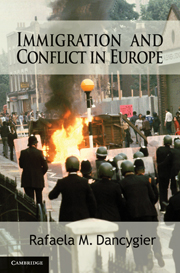Book contents
- Frontmatter
- Contents
- List of Figures and Tables
- Acknowledgments
- PART I GENERAL INTRODUCTION AND THEORETICAL FRAMEWORK
- PART II INTRODUCTION TO PART II
- PART III INTRODUCTION TO PART III
- 5 Immigrant–Native Conflict in Two London Boroughs
- 6 Two Faces of Immigrant Conflict in Two Midlands Cities
- PART IV INTRODUCTION TO PART IV
- 9 Conclusion
- Appendix A Coding Large-Scale Instances of Immigrant–Native and Immigrant–State Violence
- Appendix B Data and Variables: Immigrant Turnout
- References
- Index
- Titles in the series
5 - Immigrant–Native Conflict in Two London Boroughs
Published online by Cambridge University Press: 17 November 2010
- Frontmatter
- Contents
- List of Figures and Tables
- Acknowledgments
- PART I GENERAL INTRODUCTION AND THEORETICAL FRAMEWORK
- PART II INTRODUCTION TO PART II
- PART III INTRODUCTION TO PART III
- 5 Immigrant–Native Conflict in Two London Boroughs
- 6 Two Faces of Immigrant Conflict in Two Midlands Cities
- PART IV INTRODUCTION TO PART IV
- 9 Conclusion
- Appendix A Coding Large-Scale Instances of Immigrant–Native and Immigrant–State Violence
- Appendix B Data and Variables: Immigrant Turnout
- References
- Index
- Titles in the series
Summary
This chapter compares two London boroughs: Tower Hamlets, located in the East End, and Ealing, located on the western edge of the capital city. Only fourteen miles apart, the two boroughs' South Asian communities have fared very differently over the past several decades. While white residents in both areas reacted to nonwhite immigration with hostility and violence in the initial decades of settlement, Ealing turned itself around in the 1980s and now serves as a model of good community relations. Immigrant–native confrontations in Tower Hamlets, by contrast, only escalated over the same time period. Moreover, in Tower Hamlets interethnic conflict spread unevenly throughout the borough; by the late 1980s, the incidence of violent racism and the success of fiercely anti-immigrant parties concentrated in particular areas of the borough. What accounts for these strikingly different developments?
This chapter argues that the ways in which local economies collide with electoral contests are key to understanding intergroup relations. The starting points in both boroughs were very similar: Immigration coincided with chronic, preexisting housing shortages and immigrant demands for accommodation could not be easily sidelined by the local political leadership, for the dominant ethnic minorities in both boroughs have had considerable local electoral clout. In the context of highly competitive electoral environments, the local Labour parties were compelled, albeit reluctantly, to address the concerns of this new constituency.
- Type
- Chapter
- Information
- Immigration and Conflict in Europe , pp. 138 - 177Publisher: Cambridge University PressPrint publication year: 2010

